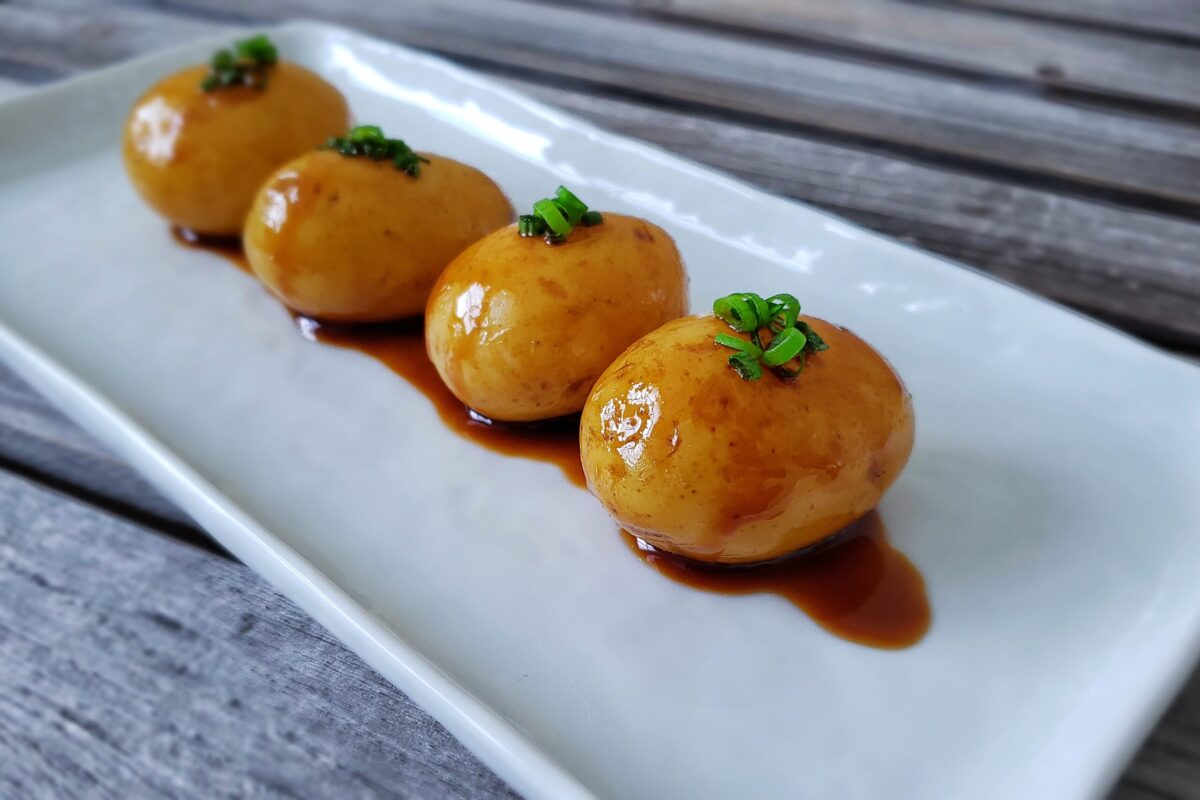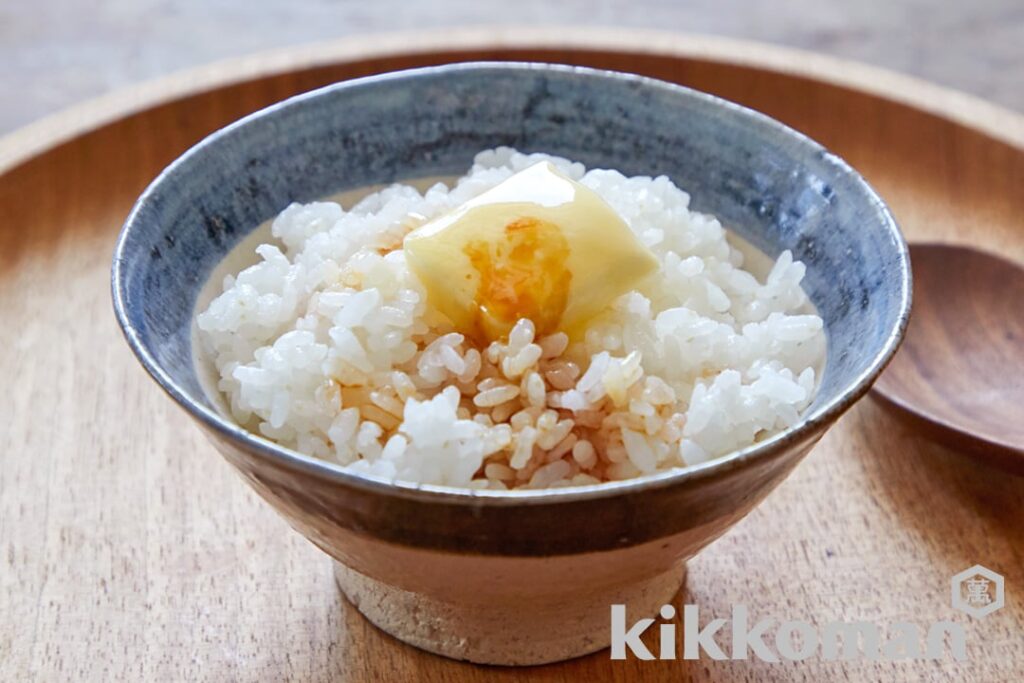Soy sauce and butter sauce are two versatile kitchen staples. Both add unique flavors to dishes.
Soy sauce, a staple in Asian cuisine, offers a salty, umami flavor. Butter sauce, common in Western dishes, brings a rich, creamy taste. Combining these two creates an unexpected yet delightful blend. Imagine the savory depth of soy sauce mixed with the creamy richness of butter.
This fusion can elevate simple ingredients into gourmet meals. Whether you’re cooking for a family dinner or a special occasion, understanding how to use soy sauce and butter sauce together can transform your culinary creations. Let’s explore the magic of these sauces and how they can enhance your cooking.
Introduction To Flavor Fusion
In the culinary world, flavor fusion is an exciting concept. It involves blending different tastes to create something unique and delicious. One such delightful combination is soy sauce and butter sauce. This duo brings together the rich, savory notes of soy sauce with the creamy, luscious texture of butter. It’s a match made in heaven, transforming simple dishes into gourmet experiences.
What Is Flavor Fusion?
Flavor fusion is the art of combining different flavors. The goal is to create a new, harmonious taste. This technique often involves mixing ingredients from different cuisines. The result is an innovative and exciting dish that surprises the palate.
| Flavor Fusion | Benefits |
|---|---|
| Combining different flavors | Creates unique tastes |
| Mixing cuisines | Offers new dining experiences |
Why Soy Sauce And Butter?
Soy sauce and butter might seem like an unusual pairing. Yet, their combination is magical. Soy sauce adds a deep, umami flavor. Butter brings richness and a smooth texture. Together, they enhance many dishes.
- Umami flavor: Soy sauce provides a savory depth.
- Creamy texture: Butter adds richness.
- Versatility: This sauce works with various cuisines.
Consider a simple sautéed vegetable. Add soy sauce and butter, and it transforms. The vegetables absorb the savory, creamy sauce. Every bite is a burst of flavor.
- Heat a pan over medium heat.
- Add a tablespoon of butter.
- Once melted, pour in soy sauce.
- Sauté your vegetables in this mixture.
- Enjoy the enhanced taste!
This combination also works wonders with proteins. Try it with chicken, fish, or tofu. The result is a dish that’s both rich and flavorful.

Credit: plantbasedmatters.net
History Of Soy Sauce
Soy sauce is a key ingredient in many Asian cuisines. Its deep, savory flavor enhances dishes and adds a rich umami taste. This versatile condiment has a fascinating history that dates back thousands of years.
Origins In Asia
Soy sauce originated in China over 2,500 years ago. It was initially a way to preserve food through fermentation. The process involved soybeans, wheat, and salt. The mixture fermented for several months, creating a liquid with a strong, salty flavor.
Early records show that soy sauce was a staple in Chinese households. It was used in cooking and as a condiment. Traders and travelers spread soy sauce to Japan and Korea. Each region developed its own variations, incorporating local ingredients and techniques.
Cultural Significance
In Japan, soy sauce is called “shoyu.” It plays a vital role in Japanese cuisine. There are different types of shoyu, each with its unique flavor profile. For example, Koikuchi soy sauce is dark and rich, while Usukuchi is lighter and saltier.
Korean soy sauce, known as “ganjang,” is often used in soups and stews. Traditional Korean soy sauce is made from fermented soybeans and brine. It’s less sweet compared to its Japanese counterpart.
Soy sauce is more than just a condiment. It represents cultural heritage and culinary traditions. It is celebrated in festivals, cooking shows, and family recipes. Its history is a testament to the ingenuity of ancient cultures in food preservation and flavor creation.
The Magic Of Butter
Butter, a humble kitchen staple, holds a special place in many cuisines. Its rich flavor and creamy texture can elevate any dish. Combined with soy sauce, it creates a sauce that is both savory and comforting. This unlikely pairing brings out the best of both ingredients, resulting in a delightful culinary experience.
European Roots
Butter has deep roots in European cooking. It has been used for centuries in various dishes. In France, butter is a crucial ingredient in many sauces and pastries. In Italy, it is often used to enhance the flavor of pasta and risotto. The versatility of butter makes it a favorite among chefs and home cooks alike.
Culinary Uses
Incorporating soy sauce with butter opens up a world of possibilities. Here are some culinary uses:
- Pasta: Toss cooked pasta in a mixture of butter and soy sauce for a quick, flavorful meal.
- Vegetables: Drizzle over steamed or roasted vegetables to enhance their natural sweetness.
- Meat: Use as a basting sauce for grilled or roasted meats to add depth and umami.
This combination can transform simple ingredients into gourmet dishes. Experiment with different ratios to find your perfect balance of flavors.
Combining Soy Sauce And Butter
Combining soy sauce and butter creates an exceptional sauce. It blends the rich, savory taste of soy sauce with the creamy texture of butter. This unique combination enhances the flavor of many dishes. Whether used for stir-fries, marinades, or simply as a drizzle, it adds depth and complexity.
Flavor Profiles
Soy sauce brings a salty, umami flavor. It’s a staple in Asian cuisine. Butter, on the other hand, provides a creamy, rich taste. When combined, these flavors create a balanced, savory sauce. The saltiness of soy sauce complements the richness of butter. This combination makes any dish more enjoyable.
Cooking Techniques
Using soy sauce and butter together is simple. Here are some cooking techniques:
| Technique | Description |
|---|---|
| Stir-frying | Add soy sauce and butter to a hot pan. Stir ingredients quickly. |
| Marinating | Mix soy sauce and melted butter. Use it to marinate meats or vegetables. |
| Drizzling | Melt butter and mix with soy sauce. Drizzle over cooked dishes. |
These techniques enhance the flavor of your meals. Experiment with different ratios. Find the perfect balance for your taste.
Popular Dishes
Soy sauce and butter sauce bring unique flavors to many dishes. These sauces are versatile and enhance both Asian and Western cuisines. Below are some popular dishes where these sauces shine.
Asian Cuisine Favorites
- Teriyaki Chicken: Soy sauce and butter create a rich glaze. The chicken is tender and flavorful.
- Soy Butter Ramen: This ramen features a broth with soy sauce and butter. It’s creamy and savory.
- Japanese Fried Rice: Soy sauce and butter add depth to the rice. It’s a quick, delicious meal.
- Butter Soy Sauce Scallops: Scallops are seared and then coated in a soy butter sauce. Perfectly balanced flavors.
Western Delights
- Grilled Steak with Soy Butter: A steak marinated in soy sauce and grilled, then topped with a butter sauce. Juicy and flavorful.
- Mashed Potatoes with Soy Butter: Butter and soy sauce are mixed into mashed potatoes. A unique twist on a classic side.
- Soy Butter Glazed Veggies: Vegetables are sautéed with soy sauce and butter. A simple yet tasty side dish.
- Soy Butter Pasta: Pasta tossed in a soy butter sauce with garlic and herbs. A quick, savory meal.
Health Benefits
Soy sauce and butter sauce are delicious on many dishes. Besides flavor, these sauces offer some health benefits. Let’s explore their nutritional value and tips for moderation.
Nutritional Value
Soy sauce is a low-calorie condiment. It provides important nutrients like proteins and vitamins. It also contains antioxidants that help fight free radicals.
Butter sauce is rich in healthy fats. It contains vitamins A, D, E, and K. These vitamins support various body functions.
| Component | Soy Sauce | Butter Sauce |
|---|---|---|
| Calories (per tablespoon) | 10 | 100 |
| Protein (g) | 2 | 0 |
| Fat (g) | 0 | 11 |
| Vitamin A (% DV) | 0 | 11% |
Moderation Tips
Both sauces can enhance meals but should be used in moderation.
- Soy sauce is high in sodium. Limit intake to reduce the risk of high blood pressure.
- Butter sauce is high in calories and fat. Use small amounts to avoid weight gain.
Mixing these sauces with other ingredients can balance your diet. For example, combine soy sauce with vegetables or use a butter sauce on whole grains.
Creative Recipes
Soy sauce and butter sauce bring a unique twist to many dishes. This combination can elevate simple meals and add a gourmet touch. Explore these creative recipes to enhance your culinary skills.
Simple Stir-fry
A simple stir-fry is quick and delicious. The blend of soy sauce and butter sauce adds depth. Follow these steps for a tasty meal:
- Heat a tablespoon of butter in a pan.
- Add chopped garlic and sauté until fragrant.
- Include your choice of vegetables: bell peppers, broccoli, and carrots work well.
- Stir-fry for 5 minutes.
- Drizzle with soy sauce and mix thoroughly.
- Cook for an additional 2 minutes.
Serve hot with steamed rice or noodles. Enjoy the savory flavors!
Gourmet Fusion
For a more gourmet fusion dish, try this recipe. It combines soy sauce and butter sauce with seafood:
- Start with fresh prawns or scallops.
- Melt two tablespoons of butter in a skillet.
- Add minced garlic and cook until golden brown.
- Place the seafood in the skillet and sear each side for 2-3 minutes.
- Pour in soy sauce and let it reduce slightly.
- Garnish with chopped parsley and a squeeze of lemon juice.
This dish pairs well with a side of sautéed greens or a light salad. The combination of flavors is exquisite and perfect for a special dinner.

Credit: forklovesspoon.com
Cooking Tips
Creating a delicious soy sauce and butter sauce can elevate many dishes. Here are some practical tips to help you achieve a perfect balance of flavors and a smooth texture.
Balancing Flavors
Balancing the flavors in a soy sauce and butter sauce is crucial. Start with equal parts of soy sauce and butter. Taste and adjust according to your preference.
Tip: Use unsalted butter to control the saltiness. Soy sauce is already salty. Adding too much can overpower the dish. If the sauce tastes too salty, add a pinch of sugar or a splash of lemon juice.
Here are some ingredients to balance flavors:
- Garlic – Adds a savory depth.
- Ginger – Provides a fresh, spicy note.
- Honey – Sweetens and balances saltiness.
- Vinegar – Adds acidity and brightness.
Enhancing Texture
Texture is essential for a satisfying sauce. A smooth, well-emulsified sauce coats your food evenly.
Tip: Melt butter over low heat. Add soy sauce slowly while whisking constantly. This ensures the butter and soy sauce combine smoothly.
If your sauce separates or looks greasy, add a small amount of cornstarch slurry. This will bind the ingredients together.
Here are some methods to enhance texture:
- Use a whisk – Ensures smooth blending.
- Simmer gently – Avoids breaking the emulsion.
- Add a thickener – Cornstarch or flour can help.
- Strain the sauce – Removes any lumps.
Follow these tips to create a perfect soy sauce and butter sauce every time. Enjoy the rich, savory flavors and smooth texture in your dishes.

Credit: www.nytimes.com
Frequently Asked Questions
What Is Soy Sauce And Butter Sauce?
Soy sauce and butter sauce is a savory blend of soy sauce and melted butter. It combines the umami flavors of soy sauce with the richness of butter. This mixture is perfect for enhancing various dishes.
How Do You Make Soy Sauce And Butter Sauce?
To make soy sauce and butter sauce, melt butter in a pan and add soy sauce. Stir well until combined. Adjust the ratio to your taste preference. This simple sauce can be prepared quickly.
What Dishes Pair With Soy Sauce And Butter Sauce?
Soy sauce and butter sauce pairs well with vegetables, seafood, and noodles. It enhances the flavors of stir-fried vegetables, grilled fish, and pasta. The versatility makes it a great addition to many recipes.
Can Soy Sauce And Butter Sauce Be Stored?
Yes, soy sauce and butter sauce can be stored in the refrigerator. Place it in an airtight container and use within a few days. Reheat gently before serving.
Conclusion
Soy sauce and butter sauce blend beautifully. They create rich, savory flavors. Perfect for various dishes. Enhance your meals easily with this combination. Simple ingredients, delightful taste. Try this pairing in your cooking today. Your taste buds will thank you.
Enjoy the delicious simplicity.




